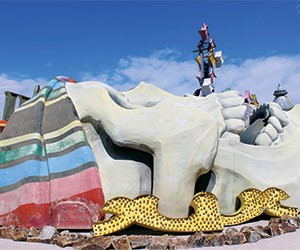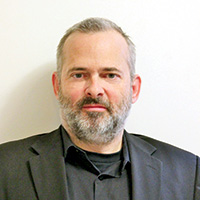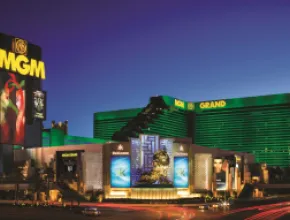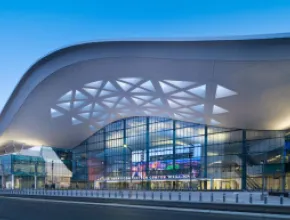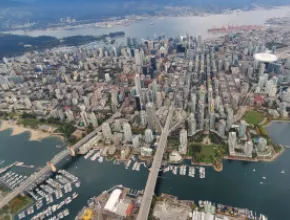Existing on perpetual reinvention, Las Vegas measures milestones and memories like few other destinations. Every square inch of this unlikely desert magnet has been redeveloped or enhanced multiple times over, investing the present day with compelling legacy allure.
While charging ahead, Vegas always takes time to honor its own, such as this April’s farewell to entertainment legend Don Rickles. His Vegas career reaching back to Rat Pack days, “Mr. Warmth” was toasted on digital marquees across the city.
In this culture of send-offs and makeovers, exalted too are people and places with staying power.
From pioneering developer Steve Wynn’s 50th year in Las Vegas to numerous property milestones, visionary leaders and anchoring institutions provide the framework and reference point for the city’s ever-evolving future.
Going the Distance
With Elizabeth Taylor and Debbie Reynolds supplying the glitz and Eddie Fisher providing the entertainment, the $15 million Tropicana Las Vegas debuted in April 1957, becoming the Strip’s 12th and southernmost property.
“As the Tropicana celebrates its 60th anniversary—a rare milestone in Las Vegas—it can look back on a history that includes attempted mob boss assassinations, topless showgirls, wild lizards, skimming scandals and corporate buyouts,” wrote David Schwartz, director of the University of Nevada, Las Vegas’ Center for Gaming Research in a recent Vegas Seven story. “The Tropicana has had a little bit of everything.”
From its original necklace-inspired Y-shape and tropical design, the “Tiffany of the Strip” has changed shape and owners over time. Gleaming white after its $200 million South Beach-style makeover in 2011, the 1,470-room Tropicana Las Vegas, flying the DoubleTree by Hilton flag, offers versatile space that includes 38 breakout rooms, a 25,000-square-foot ballroom, a 55,000-square-foot pavilion and unique venues such as the Sky Beach Club.
Nearby, New York-New York Hotel & Casino turns 20 this year, with fellow MGM Resorts International property Bellagio Resort & Casino turning 20 next year.
Named by owner Bugsy Siegel after his long-legged mistress Virginia Hill, the Flamingo Las Vegas, the Strip’s oldest surviving resort, turned 70 last year.
After celebrating 50 years in 2016, Caesars Palace feted its longest running group, the Trauma, Critical Care & Acute Care Surgery Conference, this March with a star-studded event.
Meeting at Caesars Palace every year since 1967 (see Zoom In, page 25), the Houston-based group is second in longevity only to the Vegas-based Western Veterinary Conference. Founded in 1928, the organization moved its annual meeting to the Flamingo in 1963, and save one cancellation, has met in Vegas every year since. The organization’s 70,000-square-foot Oquendo Center is an off-Strip option for groups.
For Wolfgang Puck, it has been 25 years since opening his L.A. flagship Spago at the Forum Shops at Caesars Palace. Commemorated with a luncheon at this year’s Vegas Uncork’d by Bon Appetit, now in its 11th year as the city’s premier culinary event, his daring gambit in 1992 (see Zoom In, page 22) propelled Las Vegas to global culinary stardom.
Continuing north past Palazzo Las Vegas and Encore Las Vegas, both turning 10 in 2018, the Strip corridor opens into a wide expanse of undeveloped lots and old-school anchors.
Holding the fort in this broad zone are 24-hour dining institution The Peppermill Restaurant and Lounge (45 this year); Circus Circus Las Vegas (50 next year); Stratosphere Casino, Hotel & Tower (20 last year); Golden Steer Steakhouse (60 next year); and two updated titans from the past, SLS Las Vegas and Westgate Las Vegas Resort & Casino.
Originally the legendary Sahara (1952-2011), SLS Las Vegas offers 1,300-plus stylish guest rooms in its Story and World towers, with 80,000-plus square feet of flexible space, including 30,000 square feet of dedicated meeting and convention space and a 9,000-square-foot ballroom.
Debuting in 1969 as the International Hotel, the Westgate, acquired by Westgate Resorts in 2014, recently underwent more than $150 million in renovations, including 1,200 remodeled Signature rooms, the new International Bar and luxurious new Serenity Spa.
Convention facilities at the 3,000-room icon include 225,000 square feet of flexible, renovated ground-level convention, exhibit and prefunction space; the 70,000-square-foot Paradise Event Center; and the 35,000-square-foot Ballroom and 43,000-square-foot Pavilion, accommodating 6,500 for banquets and 9,500 theater-style when combined.
Predating the Westgate by a decade, the adjacent Las Vegas Convention Center and its massive expansion (see “Full Speed Ahead”, page 14) will create a new connective hub for the area.
Some 10 minutes north but a universe apart is the city of Las Vegas (the Strip resides in unincorporated Paradise, Nev.) and its resurgent Downtown.
Flip Side of the Strip
Progress was not kind to Fremont Street, the city’s founding thoroughfare from 1905, and its environs. As the Strip soared in the 1980s, the original Sin City sank, becoming a true “down” town.
Now, after some 30 years of sustained revitalization efforts, the story is bright, not blight. Following the Fremont Street Experience (1995) and Fremont East Entertainment District (2002), the year 2012, or the “Year of Downtown,” welcomed three group-capable cultural anchors that continue to boost the scene.
Attracting more than 1.3 million visitors since its Valentine’s Day debut, the National Museum of Organized Crime and Law Enforcement, or Mob Museum, occupies the former Las Vegas Post Office and Courthouse from 1933, a national landmark, and offers evocative spaces such as the 100-person Courtroom and full buyouts.
Recently accredited by the American Alliance of Museums, the venue is targeting early 2018 completion of a $6.5 million enhancement, which includes three new exhibits—Organized Crime Today, Crime Lab and a Firearms Training Simulator—plus an on-site distillery and speakeasy.
With its visitor center housed in the relocated lobby of the La Concha Motel (1961) and outdoor Boneyard stacked with yesteryear neon and metal signs (including from the just-demolished Riviera, La Concha’s one-time Strip neighbor), the Neon Museum recently commenced a $425,000 expansion that will create adjacent display space by next year for another 30 signs.
PageBreak
Hosting productions ranging from the resident Nevada Ballet Theatre and Las Vegas Philharmonic to Broadway shows, the Smith Center for the Performing Arts offers multiple rental spaces such as the main 2,050-seat Reynolds Hall, stylish Founder’s Room and outdoor 1.9-acre Donald W. Reynolds Symphony Park.
Turning five this year is the three-day Life Is Beautiful Music & Art Festival, which attracted some 117,000 attendees in 2016, nearly doubling the crowd from its 2013 debut.
Also in 2013, the year we debuted Meetings Today Las Vegas, Zappos.com CEO Tony Hsieh launched the $350 million Downtown Project, his personal investment in a visionary revitalization of Downtown as “the co-learning and co-working capital of the world.”
Five years later, the general verdict seems to be “mixed results.”
Yet, the number of successful ventures backed by Hsieh, including new businesses, apartments, restaurants and tourism draws like Container Park and its fire-breathing praying mantis sculpture, are undeniable, and he remains committed to the project, adjusting as he goes.
And tourism has only grown. The LVCVA’s annual commissioned study for 2016 reveals that 53 percent of visitors went Downtown in 2016, significantly up from 36 percent in 2012 and 30 percent in 2013.
Fast Forward
In 1950s-era “Up and Atom” Las Vegas, patrons gathered on the rooftop of Downtown’s Atomic Liquors and other locations to watch nuclear tests just 50 miles away. In 1967, a troubled man dynamited the Orbit Inn at Fremont & Seventh. Otherwise, Downtown has gone implosion-free, preserving its stock of calling-card vintage casino-hotels and other properties.
Following a comprehensive $35 million upgrade in 2011, the 1,003-room Plaza Hotel & Casino (1971) is one thriving heirloom. Features include Downtown’s largest ballroom, offering 19,000 square feet of divisible space; a 70,000-square-foot rooftop pool deck; and former Mayor Oscar B. Goodman’s award-winning namesake steakhouse, Oscar’s.
Renamed 65 years ago from the 1949 Virginia’s Cafe, Atomic Liquors was the finish line for another blast from the past this March, the traditional parade of cars competing in the Mint 400. Established in 1967 and featured in Hunter S. Thompson’s epic Fear and Loathing in Las Vegas, this “Great American Off-Road Race” returned to Vegas for its 50th anniversary this year.
Speaking of Motor City, Detroit natives Derek and Greg Stevens have the pole position in Downtown redevelopment.
In 2012, the brothers gave the Fremont Street Experience a lodging lift with their boutique revival of the 1906 Golden Gate Hotel and Casino. That same year, they relaunched Fitzgeralds as the frisky 629-room D Casino Hotel Las Vegas, offering 11,000 square feet of versatile indoor and outdoor space, with another 20,000 square feet of space across the street at the Downtown Las Vegas Events Center.
Between 2015 and 2016, the Stevens purchased the block formed by the shuttered 1930 Las Vegas Club and three adjacent properties. Now in design, the site is slated to become their third Fremont Street casino-hotel, becoming Downtown’s first new-build property in decades.
Attracting a mix of Millennials, foreign tourists hot for vintage Vegas and gamblers (Downtown gaming is on a hot streak), this historic center, with its burgeoning Arts District, continues to build on optimism.
Authentic, walkable and amenity-rich, Downtown offers some 7,700 hotel rooms and nearly 680,000 square feet of customizable space. Planners also have the 98,000-square-foot Cashman Center and 450,000-square-foot World Market Center.
Best Seat in the House
Back at the Strip’s northern end, few sites have as many past lives as the empty 35-acre parcel facing the Wynn Las Vegas and Encore resorts across Las Vegas Boulevard.
Originally the Pair-O-Dice (1930), the site was home to the Strip’s second casino-hotel, the Last Frontier (1942). Renamed the New Frontier in 1955, it was demolished and relaunched as The Frontier in 1967.
That year, 25-year-old Stephen Wynn relocated to Las Vegas. As revealed in a 2014 Wall Street Journal interview, his arrival was pure pre-destiny.
Experienced in running his family’s East Coast bingo parlor business, the aspiring developer was invited by an insurance company titan to represent his interests in a Las Vegas property, the Last Frontier.
His first visit, in 1965, began at a Palm Springs restaurant, where Frank Sinatra was seated at the next table. Knowing Wynn’s hosts, Sinatra brought the group to the Sands. Escorted to a prime table and surrounded by stars including Elizabeth Taylor, Lucille Ball, Gregory Peck and Roger Moore, he watched the Rat Pack perform. Afterward, Sinatra came by and asked, “How’d you like the seat, kid?”
He had not intended to stay in Vegas; after that night, he could think of nowhere else. Arriving in 1967, he placed a small stake in the Frontier—and proceeded to reinvent Las Vegas.
“Better lucky than smart,” said Wynn in the WSJ interview. Count daring high-stakes moves, too, in game-changing gambits including The Mirage, introducing the mega-resort era in 1989; Treasure Island Hotel & Casino (1993, now privately held by another mogul, Phil Ruffin); and the $1.6 billion Bellagio (1998, now MGM), ushering in the high-end era.
Clad in shimmering copper-brown glass, the $2.7 billion Wynn Las Vegas (2005) and sibling Encore (2008), offer some 4,750 rooms, suites, villas and apartments combined, with 200,000 square feet of meeting space at Wynn and another 60,000 at Encore.
The Frontier was demolished a decade ago, and with the proposed redevelopment of the site as Alon Las Vegas yet to find traction, remains empty.
In emphatic contrast, Wynn is having fun proceeding with his latest reinvention, the $1.5 billion transformation of the golf course backing his resorts into Paradise Park.
Slated to break ground late 2017 or early 2018 and targeting completion by late 2019, the project creates a Caribbean-like beach environment, including a 20-acre crystal- clear blue lagoon, 1,000-room hotel tower, and nightclub and entertainment complex.
Miles to Go
Acclaimed author of several books on casinos, gambling and history, David Schwartz is an eminently knowledgeable and engaging speaker for groups interested in learning about Vegas resorts and gaming.
“Milestones mark points in history, letting you know where you have gone and how far you have progressed, where you are now, and perhaps, where you are headed,” said the Atlantic City native, in Las Vegas since 2001. “In Vegas, the emotional connections and memories are so strong for so many people that they get etched a little deeper.”
Now on a major post-recession upswing, has Vegas finally found stability and resistance against the traditional up and down cycle?
“That’s hard to say, because if Las Vegas stops evolving, it is in big trouble,” Schwartz said. “Whether for meetings attendees or leisure travelers, the city has to stay nimble because the rate of change has increased. There may be overlap, but what people want in 2017 will be different in 2021.”
Certain is continuing competitiveness in the meetings industry.
“I think people will want even less ‘out-of-the-box’ and even more customization,” Schwartz said. “Vegas will have to respond not with bigger, or even better, but with a better fit for groups.”



